Year: 2003
Directed by: Jonathan Mostow
Written by: John D. Brancato & Michael Ferris (story & screenplay), Tedi Sarafian (story)
IMDB Reference
Degree of Cyberpunk Visuals: High
Correlation to Cyberpunk Themes: Medium
Key Cast Members:
Terminator: Arnold Schwarzenegger
T-X: Kristanna Loken
John Connor: Nick Stahl
Kate Brewster: Claire Danes
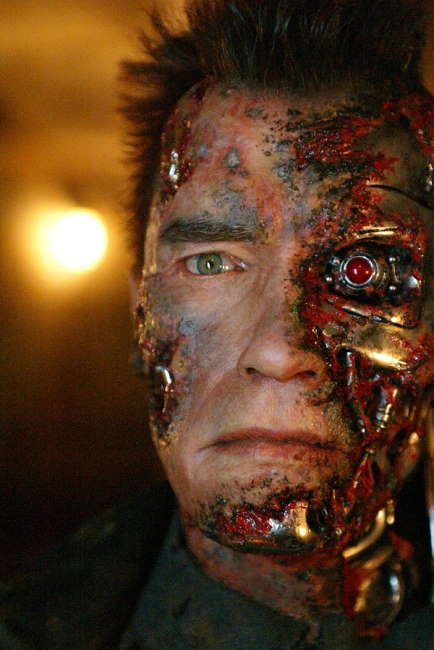
Overview: What happens if you take the original Terminator idea, morph it with T2, get rid of any semblance of a coherent, cool story, but add a really hot chick in leathers kicking butt to it? Answer: Terminator 3: Rise of the Machines! Director Jonathan Mostow really kicks the FX up a notch, but unfortunately, the story fades into more of a prop than the centerpiece it was in the first two movies. While the key cast members are all fine (terrific in the case of Lokken), they can only work with what they’re given.
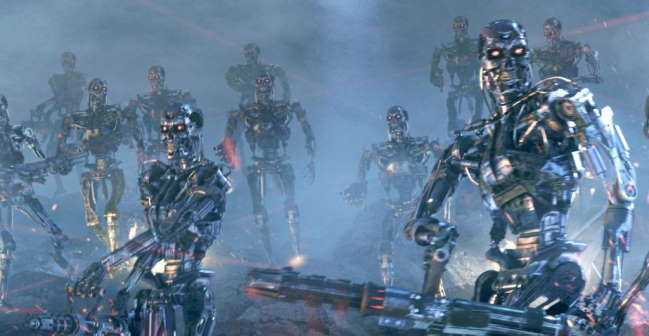
The Story: In Terminator 3, 10 years have passed since John and Sarah Conner destroyed Cyberdyne Systems and stopped the Skynet apocalypse. Unfortunately, it seems that the future is not what we make of it (As Desirina reminds us in the T2 comments), instead, fate is now predetermined. Why? Who knows…roll with it, buddy. You’ll get no well thought philosophical time travel notions here. Instead, the Terminator mystique is just that – a façade to get us to the juicy action sequences!
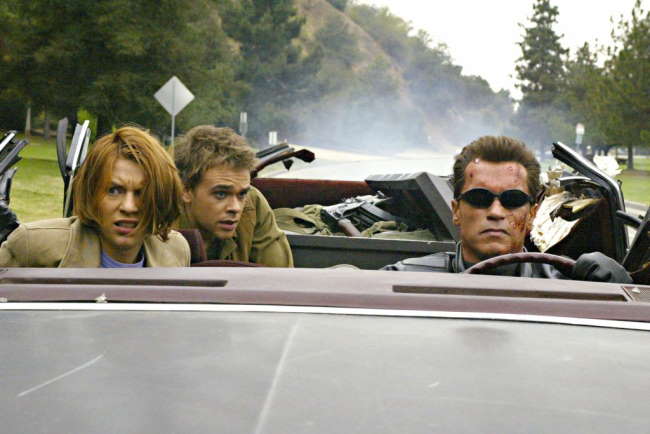
Over the years, John Conner (Nick Stahl) has turned into a drifter – he never really believed that the end of the world was abated, so he has spent his life leaving no clues as to his existence (no phones, bank accounts, and FORGET that damn phonebook!). He wrecks on his motorcycle, and due to his fear of hospital records, decides instead to break into a local veterinarian’s office and take some random medicine in the hopes that it’s a pain reliever (apparently, in the future time of 2003 the west has forgone local clinics that treat illegal aliens without recording their names and addresses). It just so has it that Conner has broken into a vet where Kate Brewster (Claire Danes), a former junior high fling of Conner’s, works.
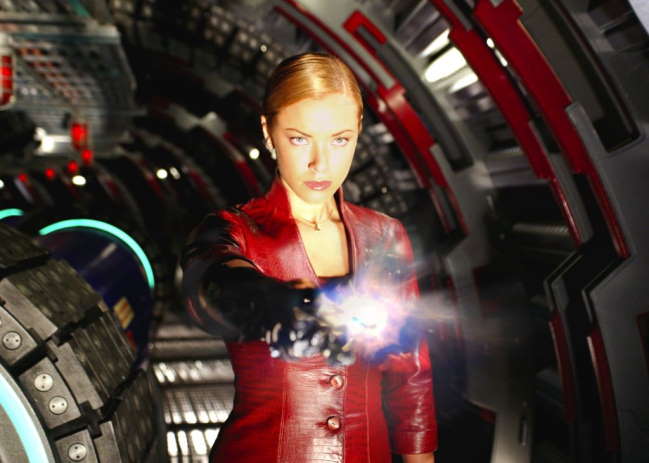
While this is going on, The TX (Kristanna Loken), or Terminatrix as Conner refers to her, arrives from the future. The new Terminatrix is nanotechnology enabled, and can control all computer networks and most electrically powered machines - in short, she’s a badass. Because Conner has all but disappeared, her mission is to bump off his lieutenants, and if possible, to then locate and terminate Conner. Arnold Schwarzenegger as the obselete CYberdyne Systems 101 model is once again captured in the future and dispatched in an attempt to save John Conner, and his future wife from the nuclear holocaust, and if possible, protect them from the Terminatrix.
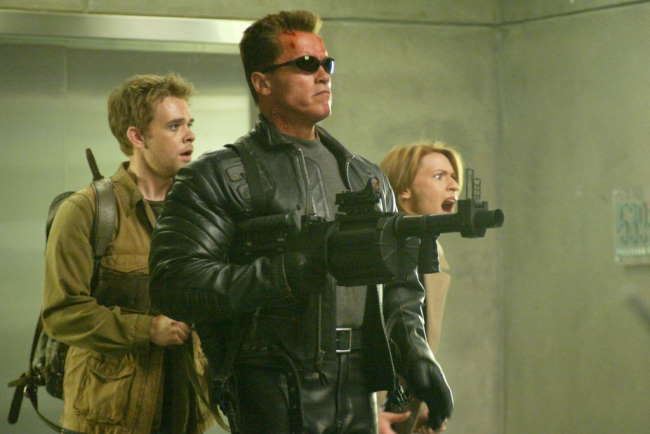
Philosophical Problems: I understand the desire to “go to the well” once more in the Terminator series, but it seems like they could have been a little more sophisticated in how they went about it. For instance, why, if Skynet is going to keep sending Terminators from the future, doesn’t it send them all back to 1984? Even a little throwaway line, similar to Star Trek’s magical matter-anti-matter converter, telling us that this isn’t possible would have helped this. Also, there’s the problem that Skynet’s grid was smashed in T1 – which was the whole purpose for the last ditched desparate attempt at a retroactive abortion. If the grid has been smashed (which if Skynet is an AI, what does this even mean?), how is it that Skynet can keep on producing newer Terminator models? Clearly, things are going all that badly for Skynet. I almost envision Skynet being in it’s “last throes” as similar to another conflict in today’s time.
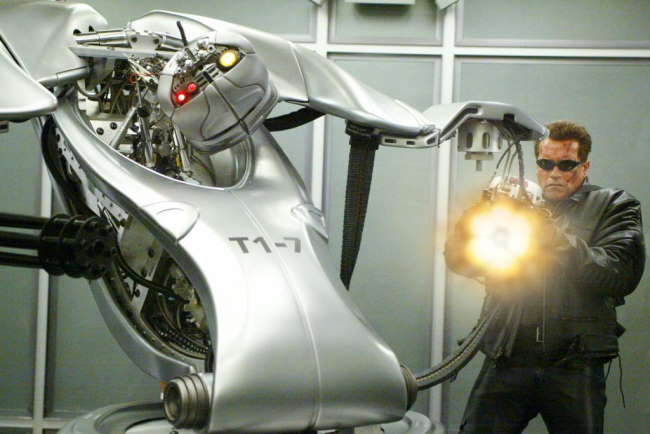
In T3, we get to see the first model Terminator.
More harmful than the problems above is the issue of fate being predetermined. Um, OK, sure, I suppose it could be, but couldn’t they have tried to justify this a bit more? The Original Terminator provided us a wonderfully nuanced time loop; Terminator 2 at least still kept a pretty solid story with the idea that the future is what we make of it. Terminator 3 basically says, “Fuck it. You’ll all screwed anyways, so lets just throw down!” And throw down they do.
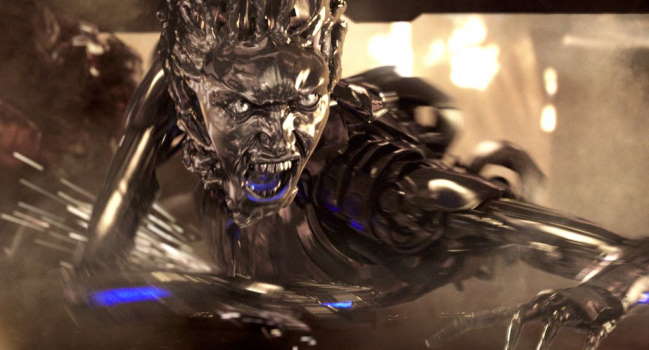
The FX: Although the story takes a significant hit in T3, the special effects do indeed rock in an over-the-top sort of fashion. I thought the truck-car race was a bit too over-done, but I LOVED the Terminatrix’s FX. And truly, Kristanna Lokken played her wonderfully. I loved her facial expressions and demeanor. She knew what the part was supposed to deliver (a hot android terminator chick kicking ass) and did it wonderfully. The FX surrounding her from beginning to end are reason enough to watch this movie.
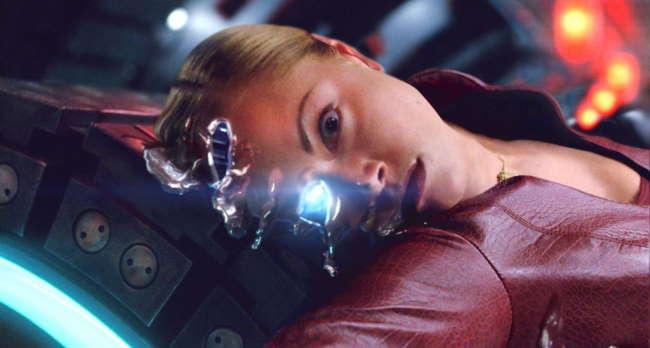
The Bottom Line: While this movie rates highly as a “hot chick kicking butt” flick, it suffers in comparison to its two predecessors as the ending to a trilogy. Terminator 3 certainly was enjoyable, but not in the sophisticated sense that the first or second one was. The sliding scale I see with this series is as follows: Terminator had an awesome story and pretty great visuals for its time; Terminator 2 delivered a very good story, and provided awesome visuals – the type that raise the bar on future movies; The third does away with the cool story but at least still delivers the visuals. In short, Terminator 3: Rise of the Machines is a bubble-gum chewing summer blockbuster, pure and simple. But on that level it works fine. However, based on the downward quality trend, if Abbot & Costello were still alive, I’d say that the next movie should be titled “Abbot and Costello Meet the Terminator.” Regardless, 5-6 stars is a reasonable place for a movie that delivers extremely well on the visuals but falls off on the story. In this case, 6 stars seems appropriate. Watch it for the FX and Kristanna Loken-Arnold battles, not for a continuation of the story.
~See movies similar to this one~
Year: 1991
Directed by: James Cameron
Written by: James Cameron & William Wisher Jr.
IMDB Reference
Degree of Cyberpunk Visuals: Very High
Correlation to Cyberpunk Themes: Medium
Key Cast Members:
The Terminator: Arnold Schwarzenegger
Sarah Conner: Linda Hamilton
John Conner: Edward Furlong
T-1000: Robert Patrick
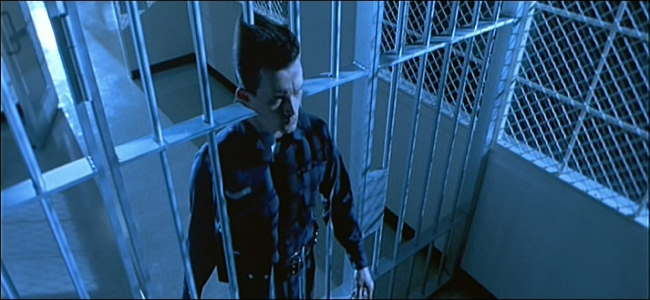
Overview: Often sequels are just made to cash in or earlier successes with a rehash of the existing story. To Cameron’s credit, he comes up with an entirely different take from the original Terminator movie, yet still maintains some level of believability to the story. Cameron certainly ratchets up the FX, but doesn’t forget the essentials that made us love the original (a well told story). Arnold Schwarzenegger returns as the Terminator, but this time he’s the good guy. Sarah Conner’s transformation from the girl next door to toughened soldier, willing to do anything to see to her son’s viability and stopping the enemy.
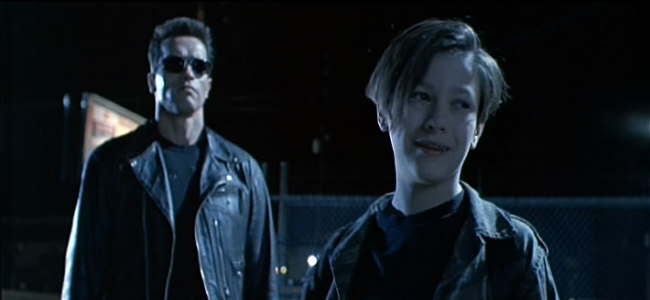
The Story: In Terminator 2: Judgement Day (T2), over 10 years have past since the events of the first movie, and the Skynet from the future has made one last attempt (um, well, until T3, that is – I believe the final last attempt will be Terminator versus Predators) to destroy John Conner. This time, they have skipped the “retroactive abortion” ploy, and are targeting him directly. This time, they are sending a more advanced unit – the T1000 – an android made out of liquid metal. The T1000 has the ability to copy virtually anything it touches, but prefers to assume the form of a police officer (Robert Patrick) to aid in its pursuit of John Conner.
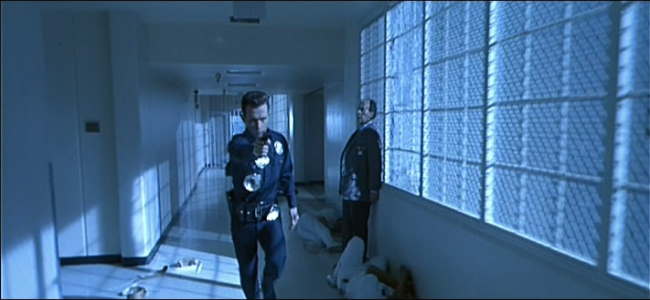
John Conner of the future, in a desperate attempt to save the gains made, captures, reprograms and sends back Cyberdyne Systems model 101 (Arnold Schwarzenegger) to protect John Conner in the past. His primary mission is to ensure John Conner’s survival by any means necessary. A secondary aspect of his programming states that he must take orders from John Conner.
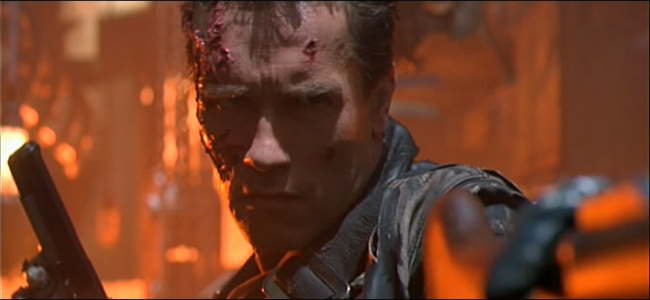
John Conner is currently living in a foster home, as his mother has been committed to an insane asylum by the good Doctor Silberman (Earl Boen). Now, disenchanted to learn that his mother has basically fed him a fantasy his whole childhood, he has become a troublesome youth. He spends his time stealing money from ATMs, jerking off with friends, and playing video games.
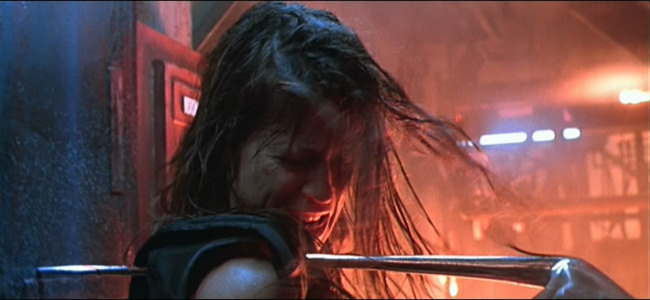
As the plot evolves, the familiar chase and pursuit feeling from the first movie returns, only this time we get the added benefit of Terminator on Terminator conflict. John Conner eventually hooks back up with his mother, and they decide to make an attempt to eliminate Cyberdyne Systems in the present, thus, eliminating the apocalyptic future that awaits the human race. Unfortunately, the T1000 has other plans.
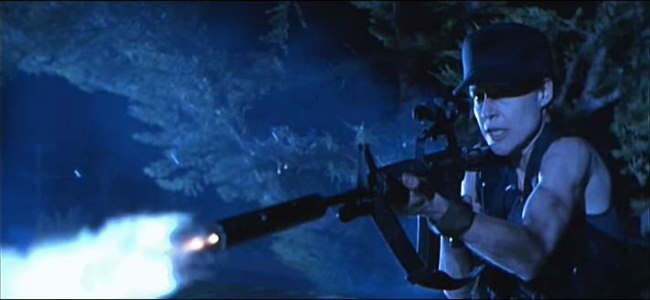
The Acting: The most impressive aspect of T2 is the personal training Linda Hamilton put in to make her transformation to a soldier absolutely believable. She really looks the part, and for a short time, almost comes across as a terminator-like powerhouse. Her acting is also spot on, as is Edward Furlong and Schwarzenegger. Robert Patrick puts in a serviceable job as the T1000, but still pales in comparison to Schwarzenegger’s character in the original. Joe Morton is also decent as Cyberdyne System’s top scientist, Dr. Miles Dyson.
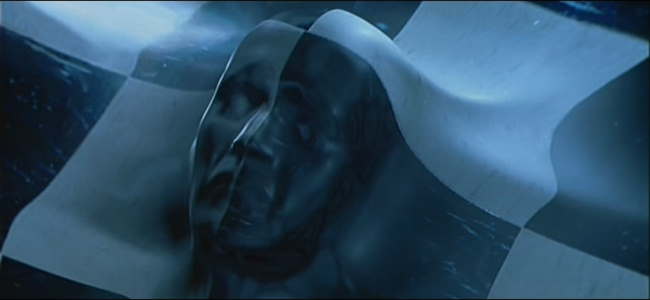
The FX: T2 is remembered for raising the bar on CG enhanced FX. Cameron transformed the T1000 into almost as large a phenomena as Schwarzenegger’s Terminator became in 1984. The liquid metal effects had the benefit of looking ultra-cool while not requiring the detail necessary for facial features. In this way, Cameron really played to the strength of the available technology. However, over time, as FX have continued to evolve, the impact of the T1000 has been significantly diminished, while the original Terminator is more embedded in our psyche than ever.
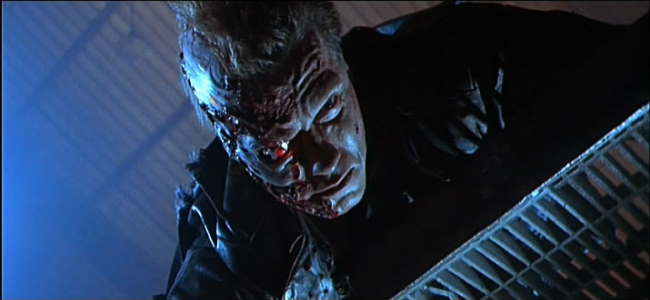
The Bottom Line: While T2 is a very well made film, personally, I still like the original lots better. Simply put, the movie is a very well made sequel, and still includes the best android fight on film. But in my mind it’s not nearly as sophisticated in terms of the whole Time Travel angle, and worse, it invalidates a key part of the original story – that nobody goes through after the first pairing. One wonders why they Skynet of the future didn’t just send the T1000 back to the same time as the first movie – then they’d have 2 Terminators pursuing Sarah Conner (or 3, 4, or 5 depending on how many Terminator movies we finally end up with). Still this is a minor point, and I know of many who disagree with me about the original being better.
T2 Page 2: More Screencaps–>>
~See movies similar to this one~
Year: 1999
Directed by: Andy & Larry Wachowski
Written by: Andy & Larry Wachowski
IMDB Reference
Degree of Cyberpunk Visuals: Very High
Correlation to Cyberpunk Themes: Very High
Key Cast Members:
Neo: Keanu Reeves
Trinity: Carrie-Anne Moss
Morpheus: Laurence Fishburne
Agent Smith: Hugo Weaving
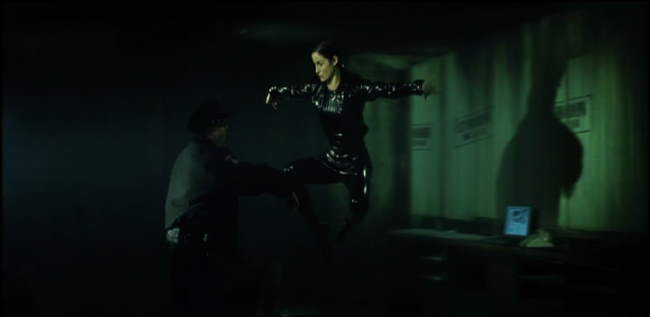
Definitely my favorite opening sequence of all time. Just a great great start to a movie!
Overview: The Matrix is one of my all-time favorite movies, so I’m just not going to attempt to come off as unbiased about it. Additionally, I’m guessing that pretty much everyone who’s coming to this site has seen it - probably numerous times, so I’m guessing a plot description isn’t of much value here. In short, my conundrum with the review is this - what should I say about this movie that will in any way add value to the reader? Answer: Not much. Instead I have decided to keep the bulk of my comments for various essays on the Matrix Trilogy.
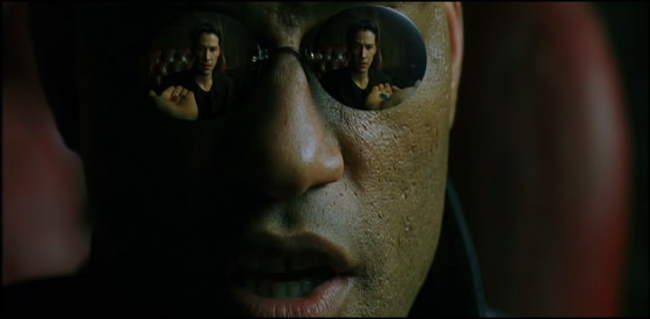
Matrix Influences: The Matrix influenced movies in general and society as a whole. With respect to movies, we see numerous influences, including:
- Special Effects: Bullet time and a myriad of other FX are now standard practice in movies and commercials
- Synonymous with “Cool”: Movies that have a “matrix-like” feel are advertised all the time. We know what this means - it means they aspire to be ultra-sleek, ultra-cool and the “in” thing.
- Fight Sequences: By hiring Hong Kong Martial Arts master Yuen Wo-Ping to coordinate the fights, the Matrix raised the bar on mainstream American movie fight sequences
- Matrix Source Code: The Matrix source code, taken in part from Ghost in the Shell, is everywhere now, and is instantly recognized, as is its meaning
- Hot Chicks in Black Shiny Stuff Kicking Butt: Trinity’s influence has massively upped the anty on action chicks in movies. While Michelle Pfeiffer’s Catwoman in Batman Returns re-initiated this trend, Carrie Anne Moss’ Trinity has made this outfit almost mandatory for female action heroines.
- The use of philosophy in movies: The Matrix seems to have broken the barrier to discussing philosphy in movies. Lets hope this idea lives on.
- Fashion: From Sunglasses, to overcoats to cyberpunkwear, the Matrix has changed the way people dress.

The Bottom Line: The Matrix is already one of the most influential in science fiction, and is truly one of the cornerstone cyberpunk movies in existence. We get it all here: terrific action, awesome cyberpunk concepts, incredible cyberpunk visuals, cool philosophical discussions, an absolutely awesome soundtrack (although DoomAng3l disagrees with this - see his comment below) and innovative FX. On top of this, all the leads were terrific. Reeves makes a perfect Neo, and Moss, Fishburne and Weaving give career-defining performances. Look below for move screencaps on page 2, and additional essays on the Matrix.
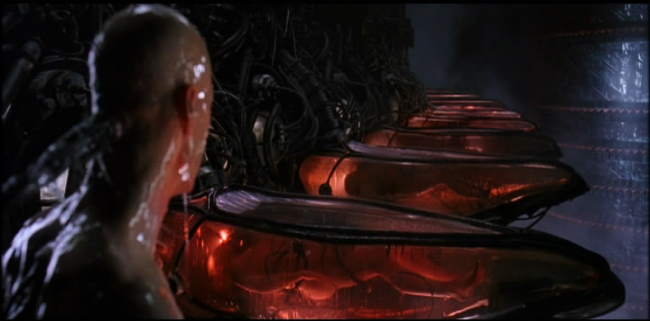
Matrix Essays
- The Matrix Trilogy: A Man-Machine Interface Perspective: This essay explores the Matrix Trilogy specifically from a scifi perspective - the purpose of which is to show how Neo’s journey is really a sequel to Motoko’s transformation at the end of Ghost in the Shell. Developed throughout the trilogy, Neo becomes a fully merged entity comprised of a sentient program with a human.
Page 2: More Screencaps–>>
~See movies similar to this one~
Year: 1993
Directed by: Hiroshi Fukutomi
Written by: Yukito Kishiro (Manga), Akinori Endo
IMDB Reference
Degree of Cyberpunk Visuals: High
Correlation to Cyberpunk Themes: Very High
Key Cast Members:
Gally (Alita): Miki Itô
Ido: Kariya Shunsuke
Yugo: Kappei Yamaguchi
Chiren: Mami Koyama
Vector: Shigeru Chiba
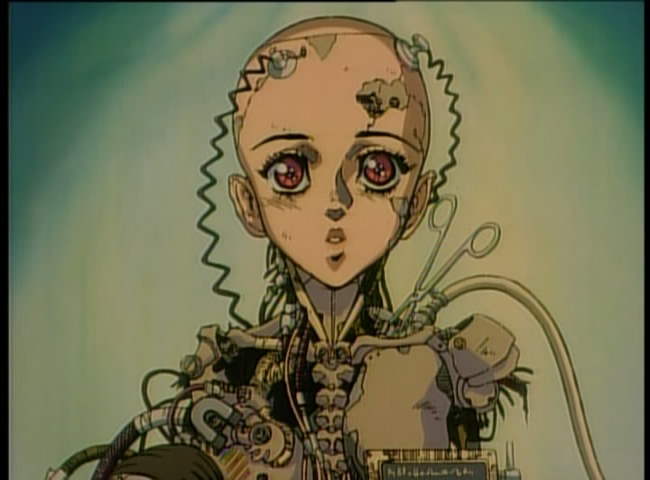
Overview: Battle Angel is based off a very well done Manga series called Battle Angel Alita. The movie covers the first two volumes of the Manga: Rusty Angel, which documents Alita’s “rebirth” and Tears of an Angel, which portrays a tragic love story. This anime from 1993 is one of the best man-machine interface animes out. The story is solid, and the drawing for that time period is terrific. While you might hear some gripe that the Manga is better, I think Fukutomi did a terrific job in taking Kishiro’s story to anime. I can only hope that James Cameron does a similarly wonderful job with the upcoming live action version of this. Just a warning - this is not a kids story - it contains lots of blood, head removals and minor amounts of nudity.
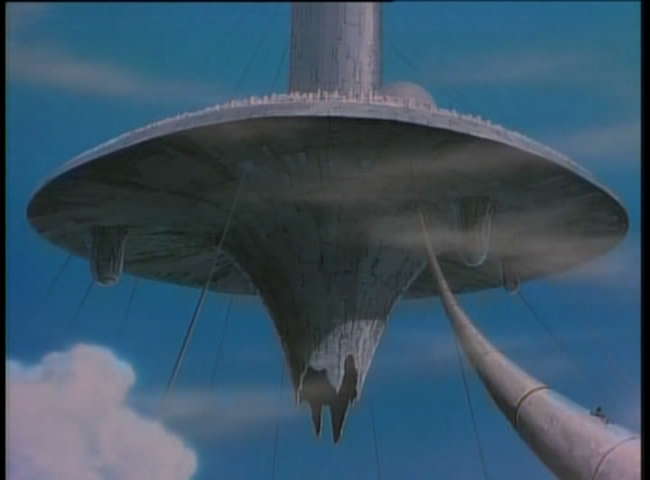
The Setting: Battle Angel takes place far into the future, after a societal collapse has occurred. Advanced human society has been relegated to a floating city called Zalem, that sits above a refuse heap called Scrap Iron City, which is inhabited by denizens living off the scraps and waste products Zalem expels. A corporation called the “Factory,” the primary employer for Scrap Iron City, sends products back up to Zalem through a series of huge metal tubes. Cyborg technology has become a way of life, with many “humans” having only their brain remaining from their original human body host. Scavenging and theft has become a way of life for many. Backbones are a particularly sought after commodity by thieves, who sometimes will violently take them from their living hosts. As social services no longer exist, the Factory posts “bounties” for the heads of the most egregious villians, which bounty hunters, called Hunter-Warriors pursue for money.
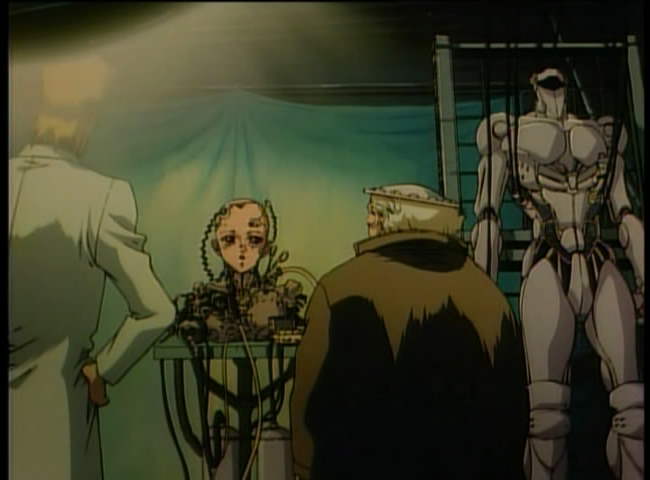
Rusty Angel: Daisuke Ido, an cyborg doctor extraordinaire, former citizen of Zalem, scavenges through the refuse heap to find spare cyborg parts to repair the citizens of Scrap Iron City. One day he comes across a female cyborg head that has a still-living human brain in it. He sets out to repair this head and gives her a wonderful body off of parts he has collected. He names her Gally (she is called Alita in the Manga), and she seems totally restored, except for the loss of memory from her earlier life. Ido becomes attached to Gally and they quickly develop a father-daughter type relationship.

Gally learns that Ido moonlights also a Hunter-Warrior both for moral reasons and to support his medical practice. Gally saves Ido from certain death, and thus, reveals that she, in her former life, was also a very talented warrior. Under protest from Ido, Gally asserts her individuality and desire to become a Hunter-Warrior like Ido, so that she too can have purpose to her life.
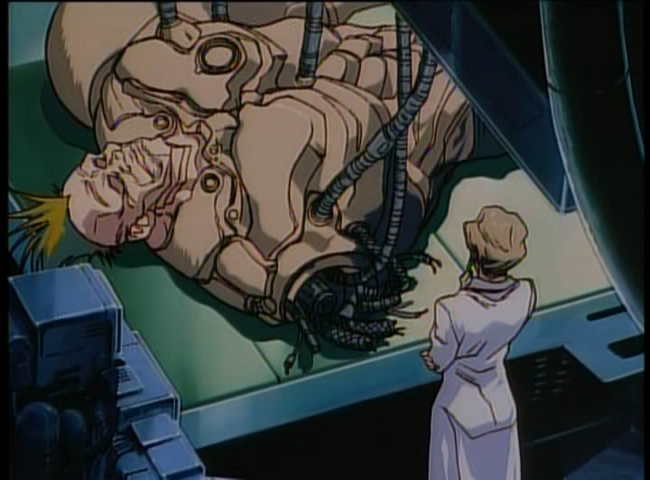
Chiren, also a cyborg doctor and Ido’s former partner, has also been ousted from Zalem, and is consumed with finding a way to return. Deciding that she will do anything to make this happen, Chiren hooks up with Vector, a shady character who has connections with the “Factory,” who agrees to eventually take her to Zalem in return for sexual favors and for her assistance in building a supra-cyborg gladiator named Greweicia for the fighting ring. This cyborg warrior also has a penchant for eating brains, and ends up on the bounty list. Chiren, wanting to be seen as superior to Ido, gets Greweicia to fight Gally in the hopes of destroying her, and thus, destroying Ido.
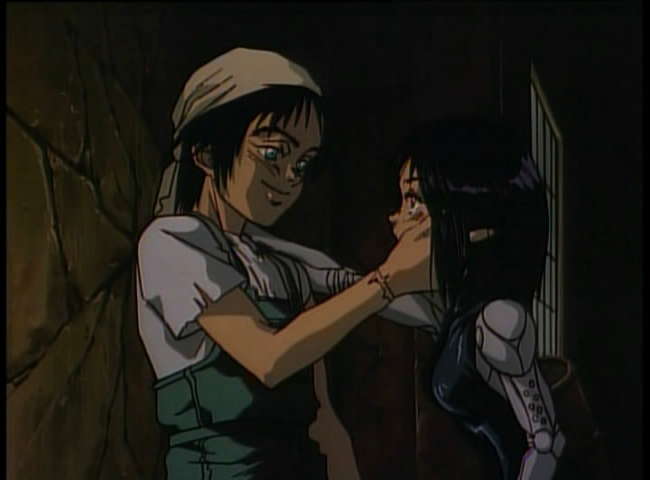
Tears of an Angel: Gally, in exploring the city has become infatuated with a hard working body named Yugo, who dreams of going to Zalem. Although it’s common knowledge that nobody born in Scrap Iron City can ever go to Zalem, Yogo is also consumed with finding a way, and has gotten an agreement from Vector, who promises Yugo if he can make 10,000,000 credits, than he will take Yugo to Zalem. Yugo has taken him up on his offer and has started stealing cyborg spinal cords as a way to augment his day job of fixing machinery. He is discovered, and is put on the Bounty list. Gally, who has fallen deeply in love with him, tries to rescue him from a rival bounty hunter. Unfortunately she is too late, but is able to save his head, and asks Ido to turn him into a cyborg. Even after becoming a cyborg, Yugo’s dreams of reaching Zalem cannot be abated, as he sees his life a struggle against the worthlessness that is the Scap Iron City.
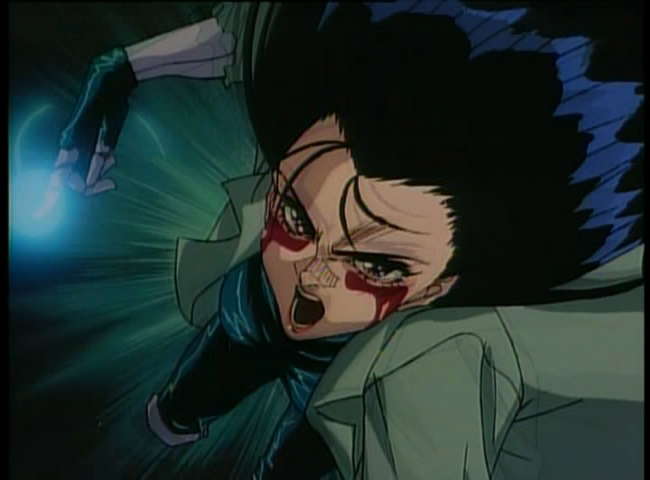
The Artwork: In Battle Angel, we see strong influences of Akira in most every aspect of the production. From the facial expressions to the darkly textured backgrounds to the fighting style approach, Battle Angel clearly has used Akira as a template for modern animation techniques. Like many OAVs of this time period, some of the backgrounds are bland while others are lavishly penned and inked with multi-layered designs. They “pick their battles” with the designs, but for the most part, the decisions are solid. The simple designs are in backgrounds such as the sky and in Ido’s house. The more complex ones are in the underground, Yugo’s hang out, and in the refuse heap scenes – this is where most of the action and plot take place.
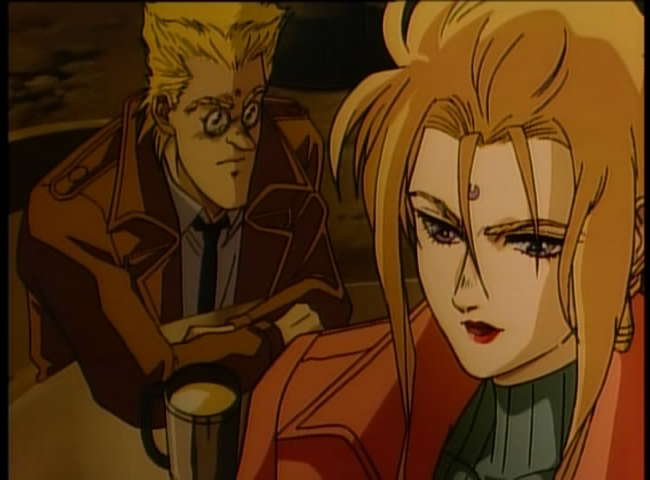
Changes from the Manga: While I think Battle Angel is a terrific anime, there are some changes from the Manga that some find annoying. Most bizarre is the renaming of Alita to Gally, and the city Tiphares to Zalem. However, unlike some, I don’t find the changes in the plot to be that problematic. The anime wonderfully captures the essence of the Manga. Perhaps the biggest change is the rationale for Alita’s powers. In the anime, we really don’t get an explanation, but in the Manga, Alita is first given a normal body by Ido, and ends up destroying it in her first fight. Realizing that Alita is a warrior at heart, Ido gives her the body he has saved for a long time – that of a berserker warrior. The primary villain in Rusty Angel is also different – he is a being who has grown up in the sewers, and after losing his body in fighting Alita, he takes over the Gladiator’s body. And Chiren, a central character in the anime is not in the first to novels of the Manga. Again, for the most part, I have no problems with the changes, and actually love the dimension that Chiren adds.
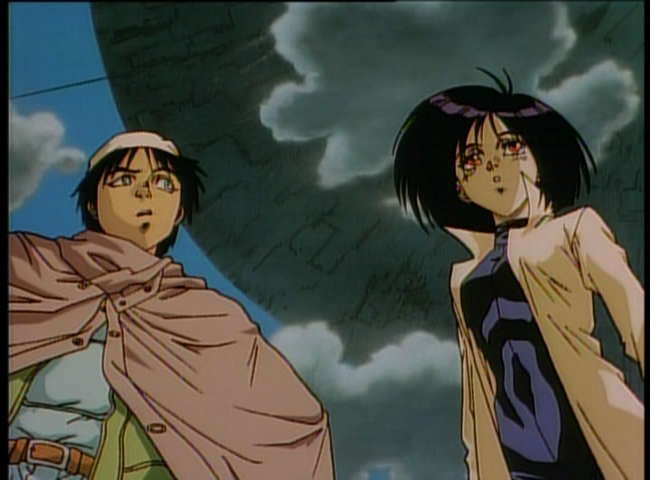
The Bottom Line: Battle Angel (Alita) just works for me as an anime. It is intelligent enough and well enough executed to get you to imagine a world where cyborgs are a reality. The world from the underground perspective is well done and Alita (I call her Alita, not Gally) as a character is terrific. Along with Armitage III and Ghost in the Shell (obviously), Alita is one of the best animes of this kind. Just a caution for those who have only seen the VHS, like most Japanese animes, Battle Angel comes off FAR FAR better with the Japanese dubbing cast than it does the English cast.
~See movies similar to this one~
Year: 1990
Directed by: Paul Verhoeven
Written by: Philip K. Dick (story), Ronald Shusett, Dan O’Bannon et al.
IMDB Reference
Degree of Cyberpunk Visuals: High
Correlation to Cyberpunk Themes: High
Key Cast Members:
Douglas Quaid/Hauser: Arnold Schwarzenegger
Melina: Rachel Ticotin
Lori: Sharon Stone
Richter: Michael Ironside
George/Kuato: Marshall Bell
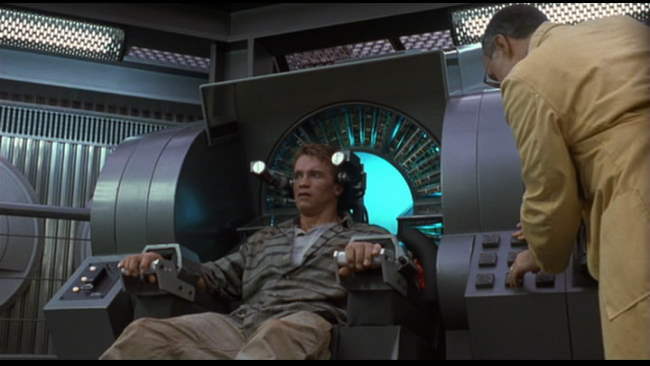
We can remember it for you wholesale!
Overview: Total Recall is one of the better known cyberpunk movies from the late 80s to early 90s. This is cyberpunk all the way with intense memory modification, a dystopic future, and malformed humans of all styles. The visuals are sometimes cheesy, but always pretty fun, and include various shots like a 3-breasted woman, exploding heads, bulging eyes, and this guy below. This is one of Arnold’s better roles, although the story does tend to rely on a continual stream of head-jerking mind fucks.
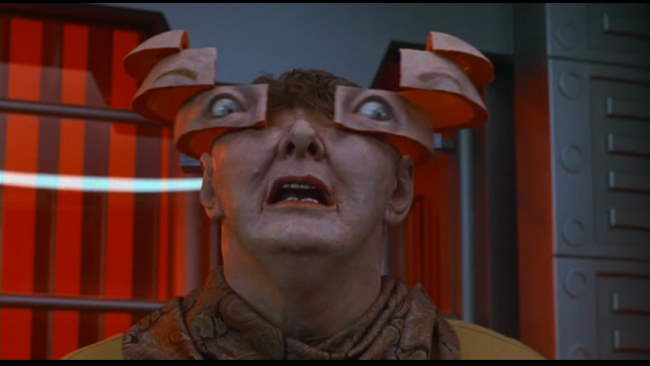
Taken from Philip K. Dick’s story, “We Can Remember it for You Wholesale,” Total Recall stars Arnold Schwarzenegger as an everyday man, Douglas Quaid, who craves something different in his life. He keeps on having realistic dreams about Mars and decides to visit Mars virtually. He goes to “the Recall Corporation” to get some memories manufactured and installed - ones that are exciting, and speak of Mars, espionage and slutty, athletic women!

Unfortunately, things go very wrong. In the process of getting his new memories installed, he wakes up to find that things are not as they seem – in fact he doesn’t know if he woke up at all, or if whether he’s still experiencing a memory impact at the Total Recall Corporation. Things get weirder and weirder, and involve a trip to Mars, and sleazy corporate plots.

Total Recall gets Arnold to truly stretch his emotion capabilities, as we get to see him act in ways he really hasn’t done elsewhere. The rest of the cast isn’t exceptional, but puts in serviceable performances. Rachel Ticotin (the slutty athletic chick), Sharon Stone (Douglas’s wife, or maybe not), Ronny Cox (the evil corporate dude) and Michael Ironside (The evil right hand guy) all provide us with memorable characters.
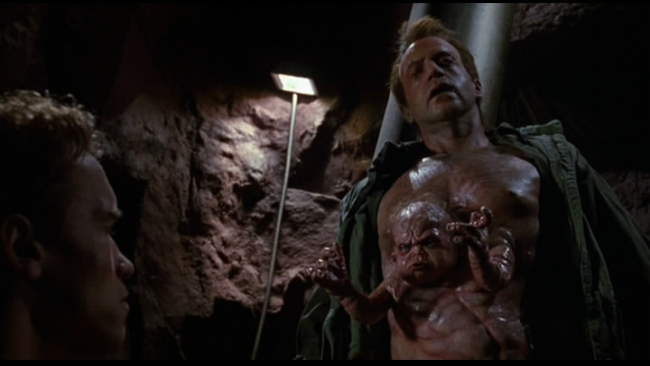
The Bottom Line: All in all, Total Recall is not the greatest movie ever, and has some significant science issues and plot holes, but it’s a truly fun ride with lots of replay potential. It does the memory modification thing very well, and while you get your head jerked around a bit, overall, the plot works.
~See movies similar to this one~
Year: 1999
Directed by: Josef Rusnak
Written by: Daniel F. Galouye (book), Josef Rusnak & Ravel Centeno-Rodriguez (Screenplay)
IMDB Reference
Degree of Cyberpunk Visuals: Very High
Correlation to Cyberpunk Themes: High
Key Cast Members:
Douglas Hall/John Ferguson/David: Craig Bierko
Hannon Fuller/Grierson: Armin Mueller-Stahl
Jane Fuller/Natasha Molinaro: Gretchen Mol
Jason Whitney/Jerry Ashton: Vincent D’Onofrio
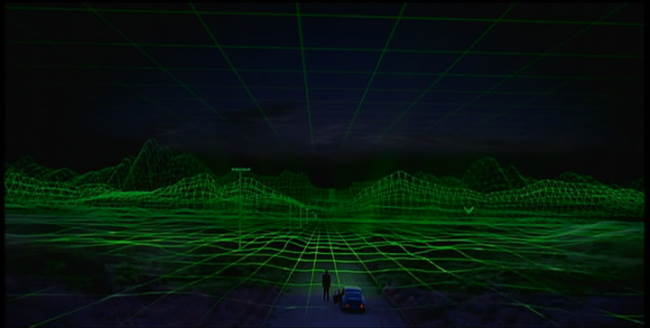
Bad fucking trip??? No…These people are real…as real as you and me.
Overview: The Thirteenth Floor is one of the truly fun virtual reality (VR) movies out that have been produced. This movie has everything from a fun film noir settings in a VR simulation, to pure mind fuck scenes, to great VR effects. The story catches you from the beginning and picks up speed as it goes. To top it off, Thirteenth Floor is loaded with style.

The Thirteenth Floor centers on a small R&D software company (located, um, on the thirteenth floor of a large building) that has created a completely realistic similated world that has lifelike VR Sims. Corporate owner and computer scientist Hannon Fuller (played by Armin Mueller-Stahl) discovers a secret so important that he’s sure someone is trying to kill him. He hides a message for his protégé, Douglas Hall (played by Craig Bierko), inside of the 1930s game simulation. After Fuller is murdered, things get truly strange. His previously unknown daughter (Gretchen Moi) comes to claim the corporation in order to shut it down, and a Detective (Dennis Heysbert) investigating the murder becomes convinced that Hall is guilty. When Hall , with the help of the lead programmer (played wonderfully by Vincent D’Onofrio), enters the “game” by taking over the consciousness of one of the game sims, he eventually learns the earth-shaking secret. Unfortunately for Hall, one of the game sims has learned it as well, and is not happy about it. At this point, the Thirteenth Floor truly takes off.
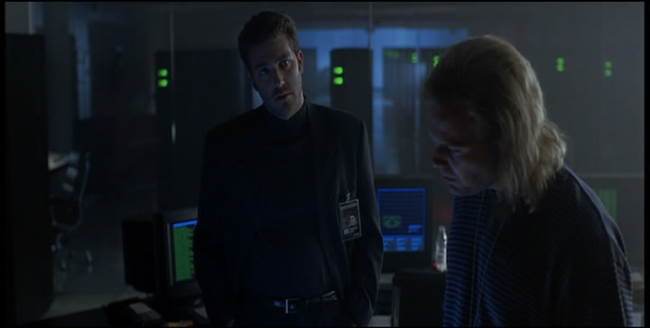
The Visuals: The Thirteenth Floor is loaded with high tech visuals in the “real” world and realistic film noir thirties visuals in the simulation. The modern visuals are sleek, with shocking neon greens, blues and reds interwoven into a dark blue-gray environment. Considering cyberpunk comes from a future-noir approach, I found the film noir add-on doubly appealing here.
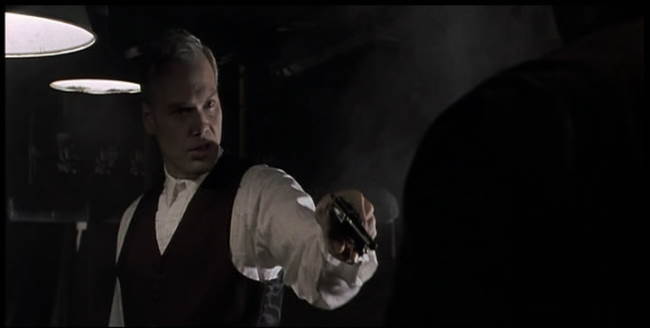
The Bottom Line: The Thirteenth Floor has a terrific cast and an interesting story that really does work for the most part. While only a few characters are given real depth, the story and effects are able to carry the show. The cinematography is truly terrific, with great use of shadows and interesting lighting contrasts. On top of this, the ending provides us with a very interesting and well done mind fuck that will stay with you for a few days. All in all, thirteenth floor also has some nice cyberpunk musings concerning the nature of reality, and whether or not we would really know if it we were actually a part of some game designer’s grand simulation.
~See movies similar to this one~
Tags: cyberpunk movie review Thirteenth Floor
Year: 2004
Directed by: Enki Bilal
Written by: Enki Bilal, Serge Lehman
IMDB Reference
Degree of Cyberpunk Visuals: Very High
Correlation to Cyberpunk Themes: High
Key Cast Members:
- Jill Bioskop: Linda Hardy
- Alcide Nikopol: Thomas Kretschmann
- Horus: Thomas M. Pollard
- Elma Turner: Charlotte Rampling
Rating: 7 out of 10

Overview: Immortel is one of the 3 all blue or green screen movies made in 2004, and is based on graphic novel, the Enki Bilal’s Nikopol trilogy, one of the best cyberpunk graphic novels ever made. Immortel provides us another cyberpunk dystopian future where an all powerful genetics engineering company called Eugenics has wreaked havoc upon most humanoid life forms. While the movie doesn’t make exactly how this dystopian future occurred, the Nikopol Trilogy (1999) relates that two nuclear wars were the primary cause. Additional contributors to a further breakdown in an already horribly diseased society include the all-powerful, oppressive Eugenics corporation which appears to be trying to cheat death through various modern “vampiristic” means. Body modification is the order of the day for most of the masses, who are continually getting skin grafts and organ transplants to mitigate the effects of the various natural and genetically derived diseases that impact all aspects of life.
Interestingly though, in the graphic novel, Biblal set the time in 2023 - 30 years after Nikopol was sent into space for these crimes. Clearly, the novel deals with an alternate reality to our own time, whereas setting Immortel so far into the future, Bilal seems to indicate that he thinks this quality of cyberpunk future may be further out than he originally thought.
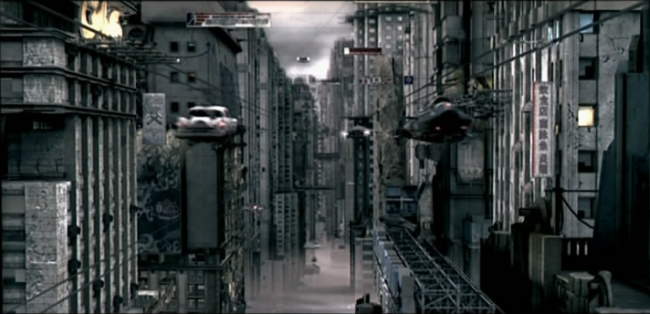
In case things weren’t crappy enough, life gets even complicated when the Egyptian Gods’ Pyramid appears - apparently the Egyptian god Horus is about to be sentenced to death by Anubis for his actions, but he is given a final 7 day furlough (one beat of an immortal heart) first. His decides to use this time to find a special woman, one of a few in the universe who can be impregnated by a God. This will allow Horus to cheat death (yes, cheating death is a pretty common theme in this). He has come to earth because his godly intuition tells him that such a woman has just arrived on earth through void between worlds. To do so, he needs to find a healthy host, but unfortunately, everyone he invades his tainted with disease and pollutants - along comes Nikopol to the rescue. Twenty-nine years prior to the time of the movie (2095), a rebel named Nikopol had galvanized public opinion against Eugenics, and for this, was sentenced to 30 years hibernation. Through an unfortunate accident, his cryogenics pod transport malfunctions and crashes, spilling his frozen body (minus his leg, which breaks off) out onto a bridge. Horus finds his body settles on Nicopol because his body, unlike virtually everyone else alive, has not been corrupted by pollutants and synthetic organs. Horus repairs Nikopol by transforming a very heavy steel rail into Nikapol’s leg. Now, if Nikapol wants to walk (the leg is quite heavy), he will need to abide by Horus’s wishes - which includes a contant need by Horus to take over Nikapol’s body.
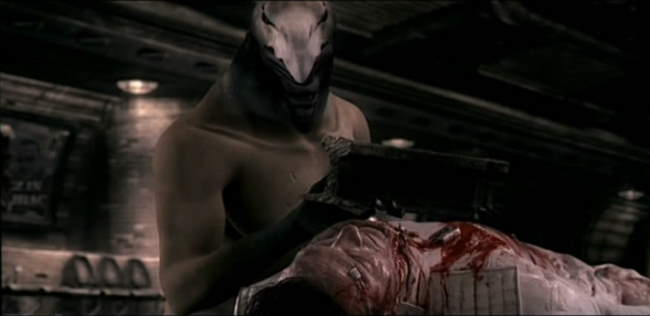
Horus, the god, and Nikopol the "terrorist" now team up to go in pursuit of a woman with white skin and blue hair (and, um blue "other" parts). It turns out that this woman, named Jill, is very mysterious in that she has no prior memories, and apparently has only been inhabiting her current body for 3 months. She is guided by a benefactor named John, who appears to be a traveler between worlds. The story proceeds with Jill being captured and studied by a friendly Eugenics researcher and Nikapol/Horus seeking her out. Unfortunately, Eugenics has discovered Nikapol’s escape (by analyzing the leg), and have sent genetically enhanced shark-like nasties after him to kill him.
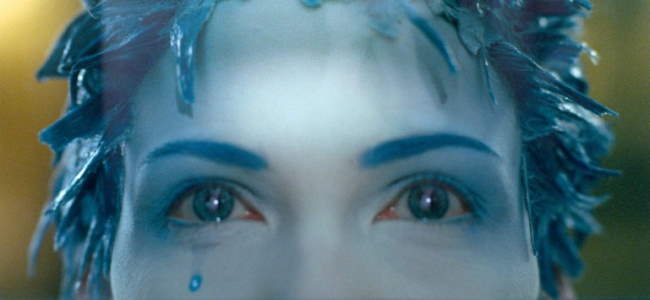
Unfortunately, there is too much going on in this movie for it all to be worked out to proper satisfaction. The pacing feels haphazard and rushed, and many interesting threads are simply not pursued to the extent I would have liked. Some scenes simply stick out like a sore thumb, without a real purpose. While I think Bilal chooses the “key” thread to complete his movie, Immortel seems begging for an extended edition type thing, where the extra meat and guts can be properly filled. Instead we are left with many interesting and completely unanswered questions. On the plus side, there is nice chemistry between Kretchman and Hardy - they have some nice love scenes and cool dialogue moments.
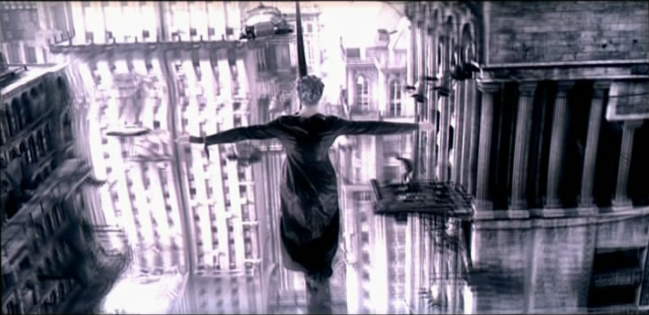
The Visuals: Wow, if there was ever a tough one to rate the visuals, Immortel fits the bill. The background scenery and many of the shots are simply stupendous - really some of the best shots I’ve seen on film are in this. The blue-haired chick, Jill, is totally sexy. Yet at the same time, for whatever reason, only 3 of the primary characters in Immortel are “real,” and the rest are poorly rendered CG characters - about even or maybe a step down from Final Fantasy. Worse, we start off with pretty strange CG Egyptian creatures (where the non-polished effects sort of work), and then jump to real ones, and then spend about 20 minutes with only lousy CG ones before returning to real characters again. Interestingly, the CG characters start getting better near the end. Its almost as if they had a separate company do these and they were learning on the job. The Bottom line with the characters though is that I see no reason why they didn’t use real actors - this would have been cheaper and more realistic. This is an example of someone getting a little too cute with the technology.
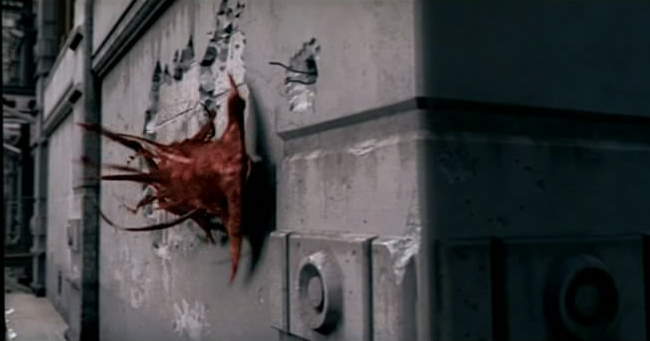
This is a shame, because again, the background scenery, and some of the shots themselves are simply breathtaking. Especially their use of a the various color palettes are simply phenomenal. Cityscapes are all done in grey-blue hue, whereas various other shots are either a dark gold-blue tone or a neon green-blue tone. Some of the creatures, specifically the Hammerhead “Dayak” shark creature is phenomenal. When he “oozes” out of the bathtub, EVERYONE watching will get the eebee-jeebees! There is a great chase scene similar to the Fifth element where the police are chasing after the two leads while this incredibly cool Dayak shark sleaks after them along the buildings. Its to the point that I refuse to believe that the DG the company who did this shark is the same one who who animated the poorly rendered people.
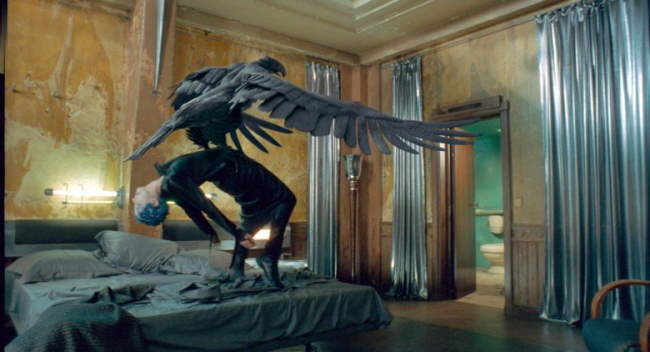
The Sound: Immortel comes with DTS sound, which is terrific. Even though this is a French film, the dialogue is in English, so no subtitles (for me) are required, except for in the Egyptian God discussions and the final monologue, which is in French. The score and music choices are absolutely spot on. They continually raise the tone and tenor of Immortel to something interesting and other-worldly. I haven’t searched for the soundtrack to Immortel, but it’s good enough that I
probably will.
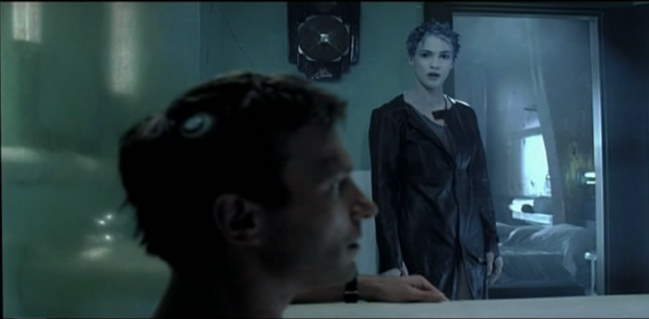
The Bottom Line: I wish there was another thirty minutes of story in Immortel to flush out the blind spots. I also wish they had used real actors for everyone instead of the CG characters. Had both of these happened, Immortel would definitely rate 10 stars. Both the pacing and most especially the CG characters were bad decisions which hurt the movie. But even having these detractors, there is enough of Immortel to make this a MUST SEE for any cyberpunk fan (and for god sakes, get the graphic novel if you haven’t already!). There are many immersive shots, augmented with wonderful sound, that left my jaw hanging (check out page 2 of this review for more screenshots). I also found enough of a story to really enjoy this - and there’s something to be said for leaving an air of mysteriousness to the film.
Immortel Page 2: More Screen Caps –>>
~See movies similar to this one~
Year: 2003
Directed by: Jun-hwan Jeong
Written by: Jun-hwan Jeong
IMDB Reference
Degree of Cyberpunk Visuals: Very High
Correlation to Cyberpunk Themes: Medium
Key Cast Members:
Lee Byeong-gu: Ha-kyun Shin
Kang Man-shik: Yun-shik Baek
Su-ni: Jeong-min Hwang
Inspector Choo: Jae-yong Lee
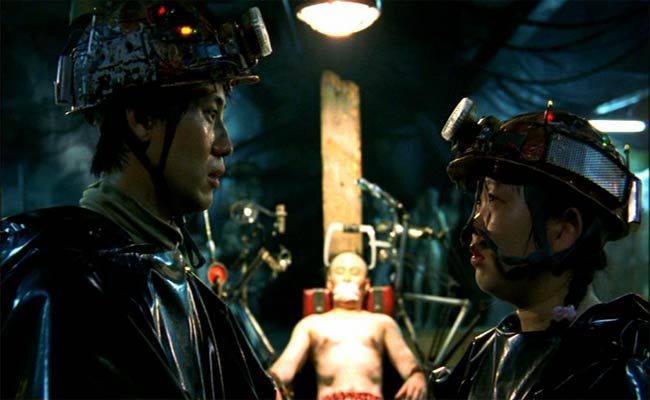
Overview: Here’s another movie that ranks really high on the weird shitometer scale - yet another cyberpunk movie from the tour-de-force of cyberpunk movies that Korea has become. Save the Green Planet is one of the only movies that has just about every movie genre represented. You’ll find everything from Gilliam-like comedy to graphic horror, to action, to scifi-thriller here. And of course, we get a large dose of Japanese-like Cyberpunk torture visuals in this terrific Korean production.
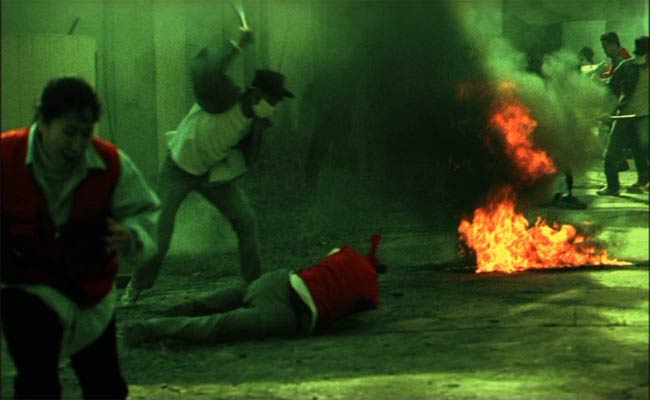
The Story: Save the Green Planet is about a completely strange guy and his even wierder ballerina girlfriend - our antihero is convinced that a certain CEO is really an alien in disguise. He has determined its his job to root the alien out and kill him if necessary, just like all the other “potential” aliens he has found in the past. After capturing him, He cuts the CEO’s hair off, as the aliens use hair follicles to communicate. He has other reasons for requiring foot torture and chest ironing. After all, good torture must always have a reason, right?
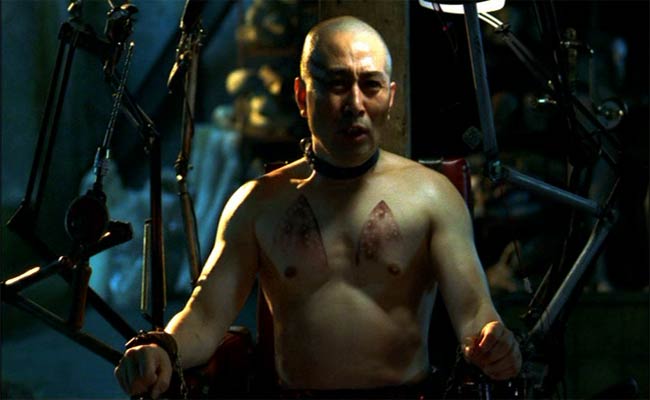
The Bottom Line: Its hard to go too much further into the plot for fear of giving key aspects of the movie away. Suffice to say the ending is terrific and fully open to interpretation, and actually has interesting similarities to the ending of Brazil. On top of this, Save the Green Planet is expertly shot, and wonderfully edited. The pacing is simply superb. It’s really hard to imagine that this is Jun-hwan Jeong’s first movie.
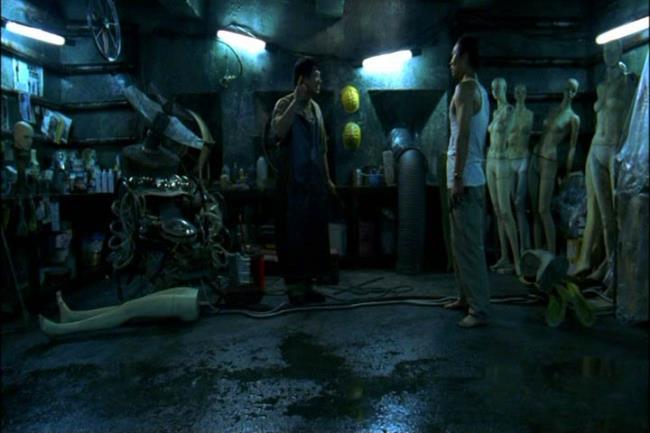
You gotta love the dolls everywhere. This guy makes them for his job.
Fair warning: Be warned though. This is a truly weird movie that his NOT for the squeemish at heart. While not a “true” Japanese cyberpunk movie in that, um, its Korean, and doesn’t totally take the “no boundaries” idea, it’s pretty darn close, and certainly merits mention in that sub-genre of cyberpunk. So much so that if you find real Japanese cyberpunk movies to be too much for you (And BTW, Tetsuo 2 doesn’t count, as this movie really doesn’t break ground and isn’t that good besides), Save the Green Planet is a decent entry to at least experience a similar pacing and mindset. Got to Page 2 for more screen caps.

Page 2: More Screen Caps–>>
~See movies similar to this one~
Tags: cyberpunk movie review Jigureul jikyeora
Year: 2001
Directed by: Mamoru Oshii
Written by: Kazunori Itô
IMDB Reference
Degree of Cyberpunk Visuals: Very High
Correlation to Cyberpunk Themes: Very High
Key Cast Members:
Ash: Malgorzata Foremniak
Murphy: Jerzy Gudejko
Game Master: Wladyslaw Kowalski
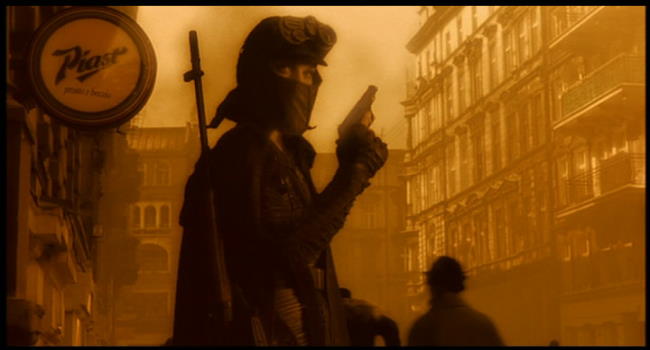
Overview: Mamoru Oshii, the master of philosophical cyberpunk animes ventures into a real world cinema production. The actors, dialogue and sets all take place in a Poland. Although this isn’t anime, the characters, cinematography and philosophy bare a striking resemblance to Oshii’s latest anime (which might show up on this list soon…). There is also many aspects of the Arthurian legend intermixed here, including the quest for the holy grail (understanding the nature of reality?), the search for the nine sisters of Avalon, and wizards, warriors and bishops. If you’re an Oshii fan, this is a must see. If you love VR game films this is a must see. If you like embedded philosophy and symbol laden movies, you will probably enjoy this. But if you’re coming purely for the action, there are probably better movies for you to spend your time on.
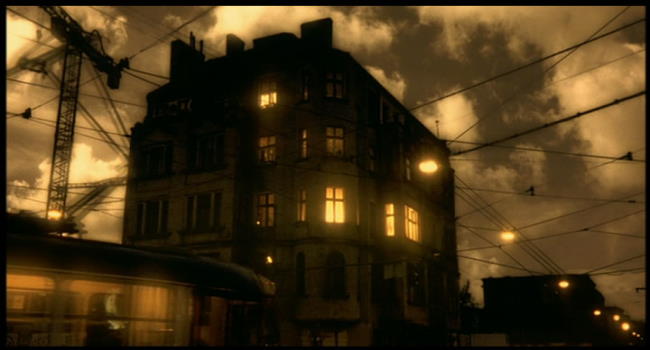
This movie takes place in a cyberpunk, dystopian future where the world is stark, devoid of real life or color, and where the only real enjoyment for young people exists in an illegal virtual reality game called Avalon. Avalon in mythical terms is the island where souls of the departed heroes come to rest. In the Virtual Reality Game of guns, tank and helicopter battles called “Avalon,” the players are the heroes, but there is a risk of actually becoming brain-dead while playing this game. In real life, the “unreturned” victims who never leave the game become human vegetables who sit around drooling in an insane asylum (this explains why the game is illegal).
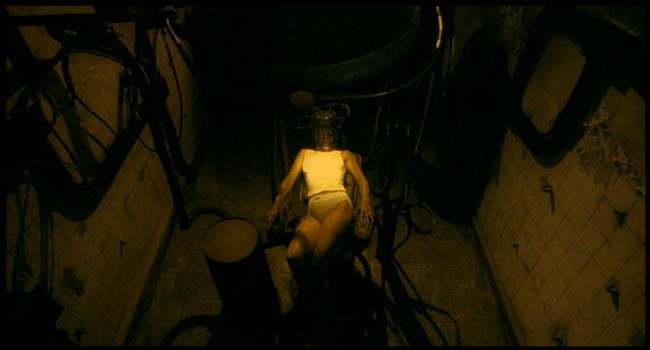
The main character is a hot warrior chick named Ash (wonderfully played by Malgorzata Foremniak). Once, she was a part of the best team in Avalon called Wizard. But something happened which caused one of the team members to panic under fire and call for a “reset” of the program (This is a traumatic action which causes all sorts of bad things to happen). This caused the team to disband and in Ash’s case, led her to be disconnected from all other players including Murphy, her team leader. Instead she becomes a supra-warrior who attempts to win the game going solo.
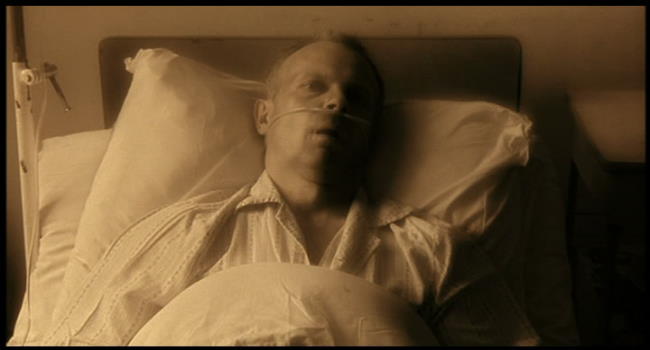
During her adventures, she learns that Murphy also went solo, and eventually worked himself up to finding a secret level called “Special A” that does not have a “reset” function. If you don’t complete the level, you don’t return. In essence, this level IS Avalon in the mythical sense. In Murphy’s case, he did not win, and ended up becoming one of the “unreturned” who lives out his “real” existence drooling in the asylum. Ash becomes obsessed with reaching this secret level so that she might find Murphy and return him. To complete this level, Ash needs to kill an illegal “unreturned” player. If she does wins, she will be offered a game admin job with Avalon. Unfortunately, Class Real is filled with “neutrals.” If Ash kills any neutral person she will lose, never to return.
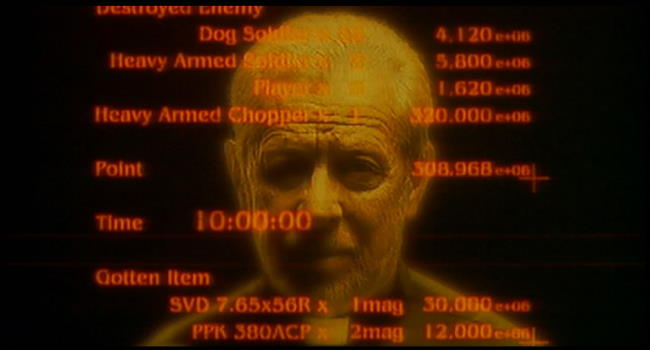
When Ash asks the Game Master if he’s real or not, his response is telling: “Does it matter if I’m real or not?” Like GITS:2 there is this notion that the line between what is real and what is imaginary almost doesn’t matter. What matters is what is actually occurring inside someone’s head: that is the “true” reality.
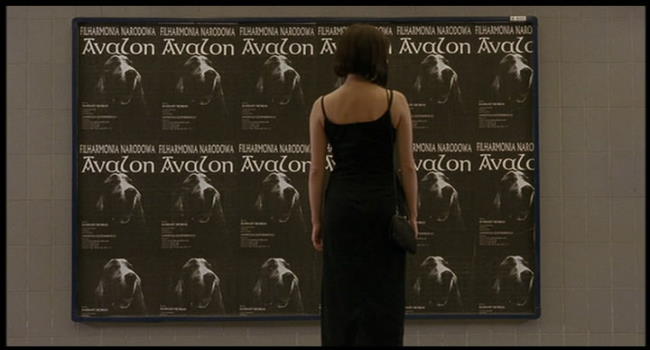
Use of a Dog as a metaphor for the “real” world: Again, similar to When Ash plays with her dog, she is participating in the “here and now.” Most of the time, Ash’s consciousness is situated in a timeless world where the actual real life moment is secondary to one’s perceptual reality. At one point early in the movie Ash wonders aloud, “Real life, is that what this is?” When she starts working at the computer, the dog goes to sleep, indicating that she has left real life and is in the game reality, if not in body, then definitely in spirit.
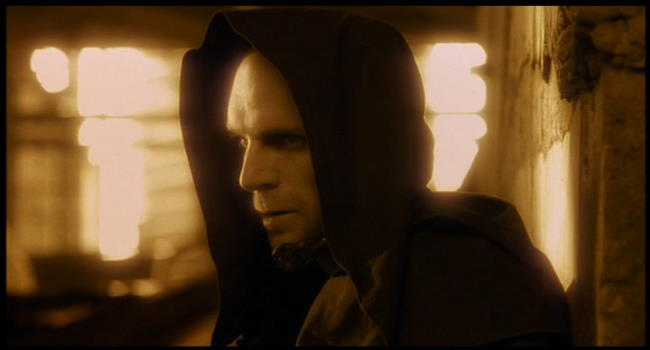
The cinematography: The cinematography in Avalon is strikingly familiar to Oshii’s latest anime. The same use of lighting, camera angles, and bright orange/yellow/brown tones are used. Interesting shots involving shadows abound. Throughout, the sets and camera pans are designed to elicit a closed-off, claustrophobic feeling. Everything, from Ash’s apartment to the train to the virtual reality headset rooms to the alleyways are bare and boxed in. Slow moving but sweeping pans add to the claustrophobia. Scenes are rarely at regular speed. Instead, the pacing is very slow moving to allow the audience time to take in the essence of the mood. In line with the pacing, Oshii continualy composes set shots similar to how he does in animes. In essence, we see glorious and elongated still shots of visually textured and wonderfully balanced objects.
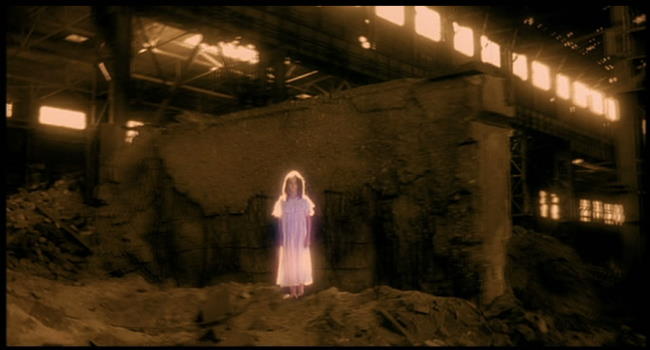
The FX and Sound: The special effects, while not on par with the high-end blockbusters, hold up well when compared to most VR type movies. Most impressive are the digitized explosions. When people and tanks "die" they digitally decompose in interesting ways. Similarly, when you enter the game, buildings auto-form. Also, the score is both haunting and moving. It highlights the slow build-up of thought and emotions. The mood of the film is clearly expressed through the score, which often serves as a catalyst for the pacing changes. As the major plot points change, so does the score radically follow suit. And the ending Avalon opera is just beautiful. I would pay to go see someone sing that.
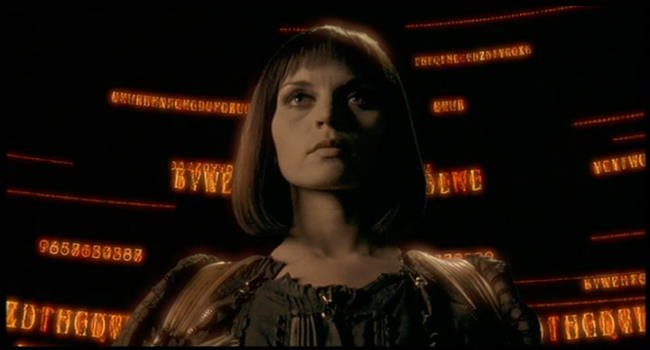
The Bottom Line: In short, Avalon is a wonderfully deep philosophical cyberpunk flick that fully explores whether reality truly matters. In essence, does it really matter if the fantasies we have running in our heads don’t really match the “reality” of the outside world? Or more to the point, is anyone really experiencing the reality of the outside world, or are we all just in our own personal Avalon? I hesitate to add more here, as doing so would spoil this most excellent movie for those few unfortunate souls who have yet to experience it. I have just one piece of advice - do so now!
But if you have seen it, I’d be happy do discuss detail philosophical thoughts with you concerning Avalon on Page 2: the Avalon Interpretive ending page. Many have expressed confusion over the ending, so I thought I’d share some thoughts on it. So if you have spoiler type questions about this movie, put them on page two (which also has more screencaps).
Page 2: Spoiler Discussion –>>
~See movies similar to this one~
Tags: cyberpunk movie review Avalon oshii
Movie Review By: SFAM
Year: 2001
Directed by: Jason Wen
Written by: Howard & Jason Wen
IMDB Reference
Length: 13 minutes
Degree of Cyberpunk Visuals: High
Correlation to Cyberpunk Themes: High
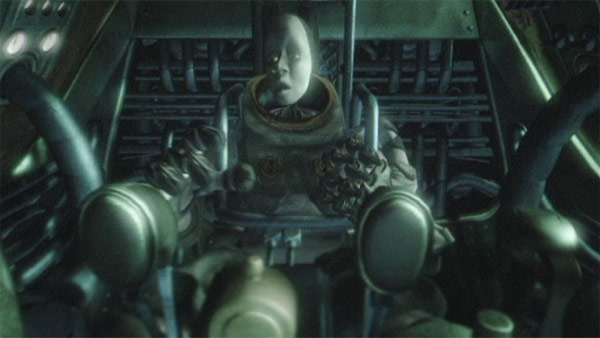
Overview: f8 is a truly wonderful 13 minute film short that captures almost all the key elements of cyberpunk without using any dialogue! f8 was well received in many of the 2001 best animated film short awards (including the Hollywood Film Festival, the Jury Award, and others). The 3D graphics, while not as high quality as might be found in a large budget movie, are more than adequate. Wen’s selection of viewpoints, lighting decisions, movement and shadows are able to emphasize the best qualities of the 3D animation.
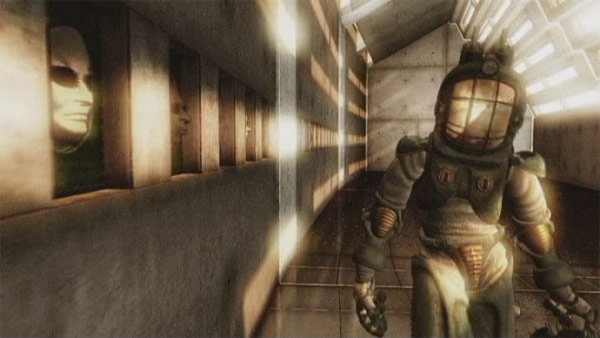
f8 centers on a nameless lead character in a strange futuristic society who wants to gain individuality. He lives in an oppressive, metropolis-like controlling society, where your fate and role is predetermined. But an underground has developed where individuality appears to be the key for admission. The plot follows the plight of our protagonist who attempts to steal a “face,” and thus, will have the ability to express an individual personality.
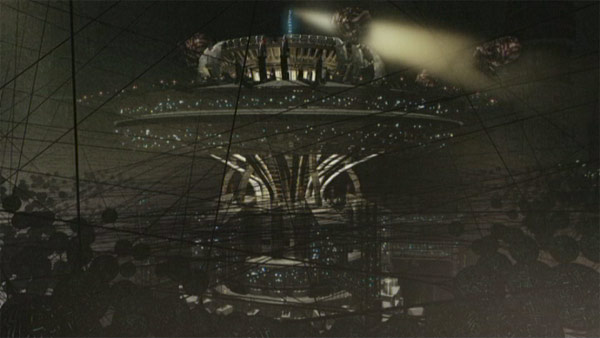
Unfortunately I cannot divulge too much more of the plot for fear of spoiling it. You can get this movie at Best Buy for about 10 bucks - even though its only 13 minutes, I think its worth it. You get 5 commentaries, and truly, the story is interesting enough that you’ll watch it more than a few times. But instead of a plot, here’s some more screen captures of it - these should give you an idea of f8’s visual splendor. Like many cyberpunk films, one color tends to dominate f8 - in this case, yellow is the predominate color.
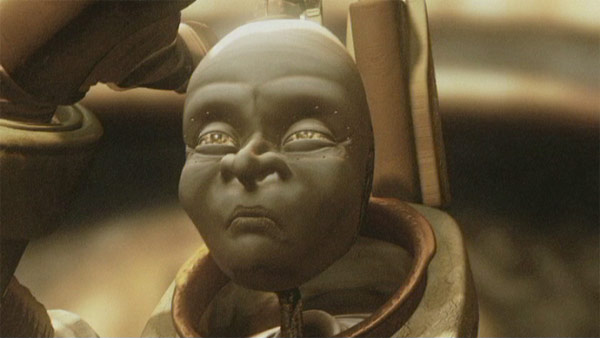
The faces are quite striking in f8 - more so even when you finally get to see their bodies!
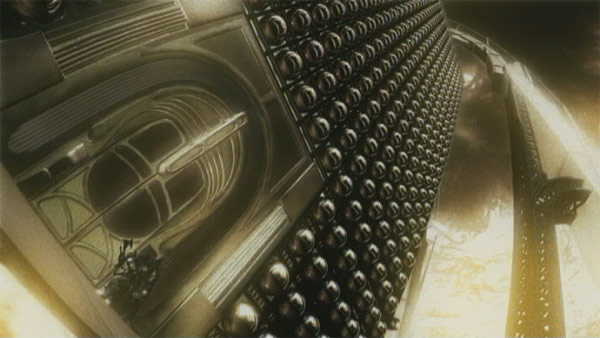
Talk about a Noirish looking building! This has all sorts of high tech, ominous vibes…
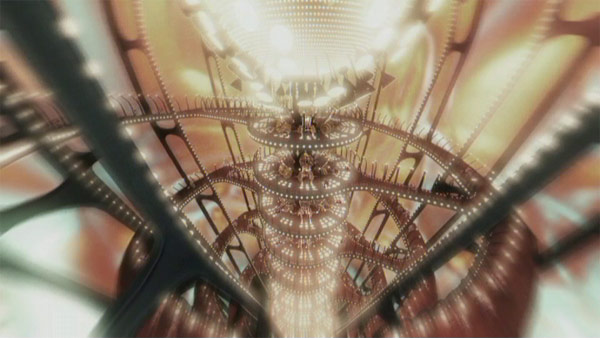
f8 has some fantastic visuals for a 13 minute film short.
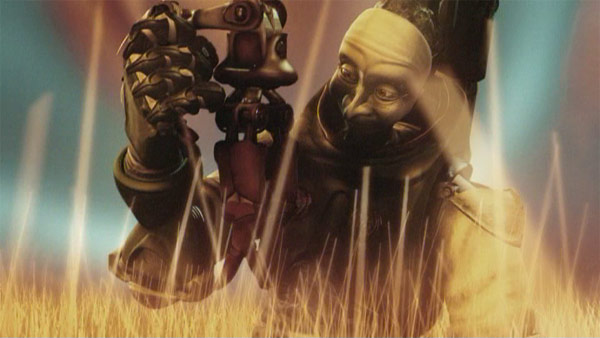
For some reason, this scene really reminds my of the scene in Nausicaä where she is walking through the field of gold tentacles.
~See movies similar to this one~
|







































































